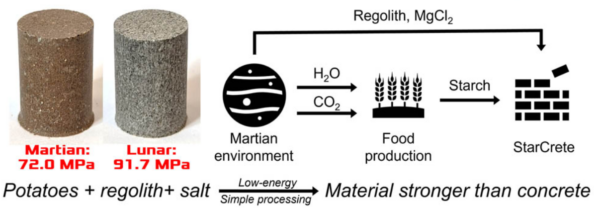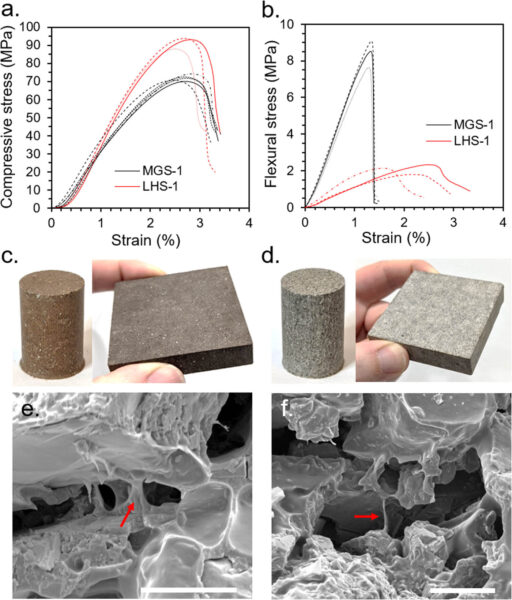StarCrete: A Starch Biocomposite for Space Construction

Researchers at the University of Manchester developed an innovative biocomposite specifically designed for extraterrestrial construction needs.
Using starch as a binder with regolith, or extraterrestrial soil, StarCrete leverages in-situ resource utilization (ISRU) to make future space habitats more feasible. Unlike traditional high-energy construction processes, this solution is both low-energy and practical, making it an ideal option for building on Mars and the Moon.
You can also read: PLA: Sustainable Future?
StarCrete Under Space Conditions
Researchers conducted rigorous testing of StarCrete using both lunar and Martian regolith simulants to determine its durability. Impressively, the material achieved compressive strengths of 91.7 MPa with lunar simulants and 72.0 MPa with Martian soil. These results are comparable to the high-strength concrete used on Earth, confirming StarCrete’s ability to withstand extraterrestrial conditions. Its strength and durability indicate StarCrete’s suitability for space habitats, offering a low-cost solution.

Star-crete: a starch-based regolith biocomposite. Courtesy of StarCrete: A starch-based biocomposite for offworld construction.
A Sustainable, Dual-Purpose Design
StarCrete stands out for its sustainable design, as it uses surplus starch from food production, addressing both building and nutritional needs. By serving as a binder, starch makes StarCrete a practical and sustainable material that aligns well with mission goals. Additionally, the starch binder could function as an emergency food source if needed, adding an extra safety measure. This dual-purpose design helps reduce resource requirements, lowering the complexity of transporting materials to space.

Scheme depicting the steps taken to produce StarCrete. Courtesy of StarCrete: A starch-based biocomposite for offworld construction.
Adaptable for Mars and the Moon
Researchers specifically adapted StarCrete to meet the dry environmental conditions of Mars and the Moon. Starch’s minimal moisture requirement allows the product to stay stable in such environments, avoiding issues faced by Earth-based materials. Its adaptability could simplify construction processes on off-Earth habitats, allowing for flexible applications in various space environments.

Stress–strain profiles for Martian (MGS-1) and lunar (LHS-1) Starcrete undergoing (a) uniaxial compression tests and (b) threepoint flexural tests. (c) and (d) Camera images Martian and lunar Starcrete, respectively. (e) and (f) SEM images of Martian and lunar Starcrete, respectively. Scale bars = 20 μm. Courtesy of StarCrete: A starch-based biocomposite for offworld construction.
Optimization and Future Research
The development team employed design of experiments (DoE) to refine the product’s formula, which included adjusting factors like starch type and gelatinization temperature. Additionally, additives like urea and magnesium chloride (MgCl₂) improved the material’s strength, showing potential for further optimization. Moving forward, the team recommends testing the product under extreme space conditions, refining regolith particle size, and exploring 3D printing possibilities.
Potential for Earth Applications
Beyond space construction, StarCrete’s sustainable design shows promise for use on Earth. Traditional cement production is a major contributor to CO₂ emissions, and StarCrete could serve as a lower-emission alternative. Although moisture sensitivity remains a challenge, future research into biopolymer additives or cross-linking methods could help adapt StarCrete for Earth’s climates. StarCrete represents an exciting step toward sustainable construction for both space and Earth applications.
